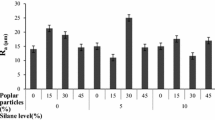Abstract
We used silane coupling agents to improve the bonding ability between wheat straw particles and UF resin, and investigated surface properties (wettability and surface roughness) and hardness of particleboard made from UF-bonded wheat straw (Triticum aestivum L.) combined with poplar wood as affected by silane coupling agent content and straw/poplar wood particle ratios. We manufactured one-layered particleboard panels at four different ratios of straw to poplar wood particles (0%, 15%, 30% and 45% wheat straw) and silane coupling agent content at three levels of 0, 5% and 10%. Roughness measurements, average roughness (R a), mean peak-to-valley height (R z), and root mean square roughness (R q) were measured on unsanded samples by using a fine stylus tracing technique. We obtained contact angle measurements by using a goniometer connected to a digital camera and computer system. Boards containing greater amounts of poplar particles had superior hardness compared to control samples and had lower wettability. Panels made with higher amounts of silane had lower R q values.
Similar content being viewed by others
References
Ayrılmıs N, Winandy JE. 2010. Effects of post heat treatment on surface Characteristics and adhesive bonding performance of MDF. Materials and Manufacturing Processes, 24: 594–599.
Azizi Kh, Tabarsa T, Ashori A. 2011. Performance characterizations of particleboards made with wheat straw and waste veneer splinters. Composites Part B: Engineering, 42(7): 2085–2089.
Baharoglu M, Gökay N, Sarı B, Bardak S, Ayrılmıs N. 2011. The influence of moisture content of raw material on the physical and mechanical properties, surface roughness, wettability and formaldehyde emission of particleboard composite. Composites Part B: Engineering, 43(5): 2448–2457.
Dahmardeh Ghalehno M, Madhoushi M, Tabarsa T, Nazerian M. 2011. The manufacture of particleboards using mixture of read (surface layer) and commercial species (middle layer). European Journal of Wood and Wood Products, 69(3): 341–344.
Doosthoseini K, Abdolzadeh H. 2010. Investigation on the feasibility of utilization wood and OCC fiber on the surface layer of particleboard and their effects on surface hardness and roughness. Iranian Journal of Wood and Paper Science Research, 25(1): 62–69.
Grigoriou AH. 2000. Straw-wood composites bonded with various adhesive systems. Wood Science and Technology, 34: 355–365.
Han GP, Zhang CW, Zhang DM, Umemura K, Kawai S. 1998. Upgrding of urea formaldehyde-bonded reed and wheat straw particle boards using silane coupling agents. Journal of Wood Science and Technology, 44(4): 282–286.
Han GP, Umemura K, Kawai S, Kajita H. 1999. Improvement mechanism of bond ability in UF bonded reed and wheat straw boards by silane coupling agent and extraction treatments. Journal of Wood Science and Technology, 45(4): 299–305.
Hızıroglu S. 1996. Surface roughness analysis of wood composites: a stylus method. Forest Products Journal, 46(7/8): 67–72.
Hızıroglu S, Holcomb R. 2005. Some of the properties of the three-layer particleboard made of eastern red cedar. Building and Environment, 40(5): 719–723.
Jarusombuti S, Ayrılmıs N, Bauchongkol P, Fueangvivat V. 2010. Surface characteristics and overlaying properties of MDF panels from thermally treated rubberwood fibers. Bioresources, 5(2): 968–978.
Markessini E, Roffael E, Rigal L. 1997. Panels from annual plant fibers bonded with urea formaldehyde resins. In: Proceedings of 31st international particleboard composite materials symposium, April 8–10, Washington State University, pp. 147–160.
Author information
Authors and Affiliations
Corresponding author
Rights and permissions
About this article
Cite this article
Hafezi, S.M., Doosthoseini, K. The influence of silane coupling agent and poplar particles on the wettability, surface roughness, and hardness of UF-bonded wheat straw (Triticum aestivum L.)/poplar wood particleboard. Journal of Forestry Research 25, 667–670 (2014). https://doi.org/10.1007/s11676-014-0505-7
Received:
Accepted:
Published:
Issue Date:
DOI: https://doi.org/10.1007/s11676-014-0505-7




